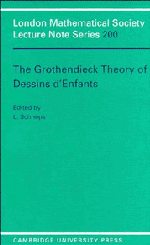Book contents
- Frontmatter
- Contents
- List of participants at the conference
- Introduction
- Abstracts of the talks
- Noncongruence Subgroups, Covers and Drawings
- Dessins d'enfants on the Riemann sphere
- Dessins from a geometric point of view
- Maps, Hypermaps and Triangle Groups
- Fields of definition of some three point ramified field extensions
- On the classification of plane trees by their Galois orbit
- Triangulations
- Dessins d'enfant and Shimura varieties
- Horizontal divisors on arithmetic surfaces associated with Belyi uniformizations
- Algebraic representation of the Teichmüller spaces
- On the embedding of Gal(ℚ̅/ℚ) into GT
- Appendix: The action of the absolute Galois group on the moduli spaces of spheres with four marked points
- The Grothendieck-Teichmüller group and automorphisms of braid groups
- Moore and Seiberg equations, topological field theories and Galois theory
Dessins from a geometric point of view
Published online by Cambridge University Press: 05 July 2011
- Frontmatter
- Contents
- List of participants at the conference
- Introduction
- Abstracts of the talks
- Noncongruence Subgroups, Covers and Drawings
- Dessins d'enfants on the Riemann sphere
- Dessins from a geometric point of view
- Maps, Hypermaps and Triangle Groups
- Fields of definition of some three point ramified field extensions
- On the classification of plane trees by their Galois orbit
- Triangulations
- Dessins d'enfant and Shimura varieties
- Horizontal divisors on arithmetic surfaces associated with Belyi uniformizations
- Algebraic representation of the Teichmüller spaces
- On the embedding of Gal(ℚ̅/ℚ) into GT
- Appendix: The action of the absolute Galois group on the moduli spaces of spheres with four marked points
- The Grothendieck-Teichmüller group and automorphisms of braid groups
- Moore and Seiberg equations, topological field theories and Galois theory
Summary
Abstract
In this paper we study the topological aspects of dessins (via analytic description) with two distinct goals. Firstly we are interested in fields of definition and fields of moduli. We give a topological proof that there exist some dessins with no model defined over their field of moduli. This answers explicitly a question asked in [Har87]. Our second motivation is to collect practical and theoretical data for the explicit computation of covers given by some topological description, following ideas of Atkin [ASD71] Oesterlé and ourselves. This leads to a method for the computation of the linear space associated to a divisor on a given dessin.
Introduction
This paper develops some practical applications of the archimedean analytic description of coverings through Puiseux series. In the second section, we recall a classical result due to Klein concerning the classification of genus zero Galois coverings, and related to the classification of regular polytopes. In the third section we give a review of many possible definitions of what a moduli field is. We do not claim to exhaust the list of various contradictory notions denoted by these words, but simply to avoid the frequent confusion about it. The fourth section is an illustration of what knowledge can be provided by local considerations at infinity. We show that such a study leads to interesting examples of coverings with strange rationality properties, which we can state by mere combinatorial considerations.
- Type
- Chapter
- Information
- The Grothendieck Theory of Dessins d'Enfants , pp. 79 - 114Publisher: Cambridge University PressPrint publication year: 1994
- 9
- Cited by



